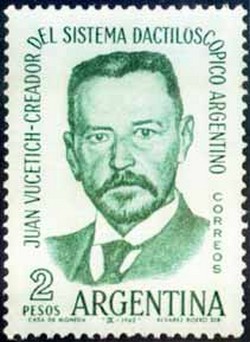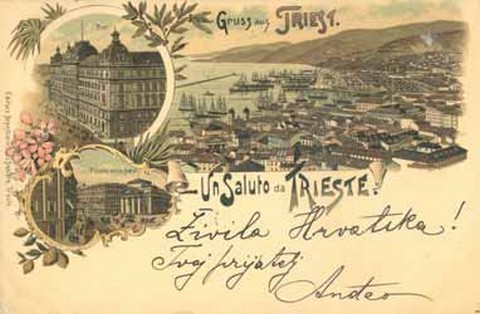
Sponsored Ads
|
» Home
» Croatian Language » Ivan Vučetić the father of dactiloscopy - fingerprinting as a method of identification
» Home
» Science » Ivan Vučetić the father of dactiloscopy - fingerprinting as a method of identification
» Home
» People » Ivan Vučetić the father of dactiloscopy - fingerprinting as a method of identification
| Ivan Vučetić the father of dactiloscopy - fingerprinting as a method of identification |
| By Ljerka Galic, prof. |
Published
10/13/2008
|
Croatian Language , Science , People
|
Unrated
|
|
|
|
Juan Vucetich, page 1
Ivan Vučetić, or Juan Vucetich (1858-1925) Four types of papillary ridges from Juan Vucetich's book "Dactiloscopia comparada" published in 1904.
Projekt "Vucetich" sastoji se iz niza multimedijskih događanja u prigodi 150. godipnjice rođenja oca daktiloskopije Ivana Vučetića / Juana Vuceticha, koji Hrvatska matica iseljenika ove godine predstavlja javnosti u Hrvatskoj i inozemstvu.
Autorica koncepcije Projekta i koordinatorica događanja je povjesničarka umjetnosti Ljerka Galic, čiji su odabrani suradnici sudjelovali u revaloriziranju kozmopolitskih značajki Vučetićeva djela s različitih znanstvenih motripta, a potom ih kreativnim postupcima oblikovali u znalačku prezentaciju tj. izložbu, čiji suvremeni diskurs podjednako snažno progovara o Vučetićevoj inovatorskoj osobnosti na globalnoj razini, osobnom stvaralačkom uzletu, ali i napem danapnjem poimanju daktiloskopije kao najjednostavnije i najrapirenije metode za utvrđivanje identiteta u svijetu. Hrvatski inovator Ivan Vučetić (Hvar, 20. srpnja 1858. - Dolores, Argentina, 25. siječnja 1925.), proučivpi vipe postojećih metoda za klasifi kaciju otisaka prstiju, ustanovio je i u praksi primijenio vlastiti sistem za daktiloskopsku klasifi kaciju. Danas je daktiloskopija disciplina kriminalističke tehnike, koja se bavi proučavanjem papilarnih linija, formiranih u raznim oblicima na jagodicama i člancima prstiju, dlanovima i stopalima u cilju identifi kacije, dokazivanja identiteta osoba, kao i počinitelja kaznenih djela na temelju ostavljenih tragova papilarnih linija.
Iselivši u Argentinu 1884. godine, kao 26- godišnjak, gdje se nakon četiri godine zaposlio u Centralnom uredu policije u La Plati, Vučetić / Vucetich se pridružio najbrojnijoj i jednoj od najstarijih hrvatskih iseljeničkih zajednica na južnoameričkom kontinentu. U Argentini, krajem 19. i početkom 20. stoljeća, postojalo je 133 naselja s oko 150 000 Hrvata, uglavnom iz Dalmacije i Hrvatskog primorja, koji su među prvim europskim doseljenicima počeli naseljavati puste argentinske pampase. Pionire s otoka Hvara slijedili su iseljenici iz drugih krajeva Dalmacije, ali i ostalih povijesnih hrvatskih zemalja, točnije teritorija današnje Republike Hrvatske.
Iako odvojeni od domovine beskrajnim prostranstvom oceana, hrvatski iseljenici poput Ivana Vučetića / Juana Vuceticha, nikada nisu zaboravili zavičaj. Iseljeni Hrvati trudili su se putem brojnih iseljeničkih društava da taj osjećaj ljubavi za domovinu i materinsku riječ prenesu i na potomke, rođene u Argentini. Argentina je započela svoje iskustvo zemlje primateljice useljenika formalno i masovno godine 1876. Vrijeme zemljoradničkih zadruga 19. st., u pokrajinama kao što su Santa Fe ili Entre Ríos, s vremenom su zamijenile gospodarski prosperitetnije djelatnosti. To je Argentinu pretvorilo u zemlju koja je spremno dočekivala ekonomski konkurentnije useljenike koji su je svojim sposobnostima tijekom dvadesetog stoljeća na međunarodnoj razini uzdigli u sam vrh zemalja s mješovitim stanovništvom. Budući je Argentina po veličini deveta zemlja na svijetu, a broji oko 33 milijuna stanovnika u 23 razvijene pokrajine i glavnome gradu Buenos Airesu - sretni smo da su i Hrvati u prvom, drugom, trećem pa i četvrtom naraštaju dionici tih argentinskih uspjeha.
Osmišljeni umjetnički diskurs izložbe Projekta "Vucetich" i njegova autorskog tima, zaslužuje sve čestitke i zahtijeva vašu posjetiteljsku kreativnu energiju kako bi Vučetićevo djelo živjelo i u naše vrijeme na dobrobit čovječanstvu.
Danira Bilić, ravnateljica Hrvatske matice iseljenika
|
The "Vucetich Project" is made up of a series of multimedia events held on the occasion of the 150th anniversary of the birth of Ivan Vučetić / Juana Vucetich, the father of dactiloscopy, presented to the Croatian and international public this year by the Croatian Heritage Foundation. The Project’s Concept Author and Event Coordinator is art historian Ljerka Galic, whose selected associates have taken part in a re-evaluation of the cosmopolitan characteristics of VuËetiE’s work, from various scientifi c aspects, subsequently creatively melded into an authoritative presentation, i.e. an exhibition, whose contemporary discourse speaks with equal potency about Vučetić’s personality as an innovator at the global level, about his personal creative ascent, and also about our present day comprehension of dactiloscopy as the simplest and most widely used method of establishing identity in the world.
The Croatian innovator Ivan Vučetić (Hvar, 20 July 1858 - Dolores, Argentina, 25 January 1925), having studied the several existing methods of classifying fi ngerprints, established and applied in practice his own system of dactiloscopic classifi cation. Today dactiloscopy is a discipline of forensic science, which studies papillary ridges, formed in various shapes on the cushions and joints of the fi ngers, palms and feet with the aim of identifi cation, of establishing a person’s identity, and the identities of perpetrators of criminal acts on the basis of remaining papillary ridge traces.
Having moved to Argentina in 1884 as a 26-yearold, where he was four years later employed at the Central Police Bureau in La Plata, Vučetić / Vucetich joined the most numerous and one of the oldest Croatian emigrant communities on the South American continent. At the turn of the 19th and 20th centuries there were 133 settlements with some 150,000 Croatians in Argentina, for the most part hailing from the coastal regions of Dalmatia and Hrvatsko primorje, who were among the fi rst European immigrants to settle in the Argentinean pampas.
The pioneers from the island of Hvar were followed by emigrants from other parts of Dalmatia, and the other historic Croatian lands, more precisely the present day Republic of Croatia.
Although separated from their homeland by the endless expanse of the ocean, Croatian emigrants like Ivan Vučetić/Juan Vucetich never forgot their native land. The emigrant Croats made an effort, by way of many emigrant associations, to pass on this affection for the homeland and the mother tongue to their descendents, born in Argentina. It was in 1876 that Argentina began, formally and on a massive scale, its experience as a receiving country for immigrants. The period of farming cooperatives of the 19th century, in regions such as Santa Fe or Entre Ríos, gradually gave way to economically more rewarding activities. This turned Argentina into a country ready to accept economically more competitive immigrants, whose abilities elevated Argentina in the twentieth century to the very peak of countries with multiethnic populations. As Argentina is by size the ninth largest country in the world, with a population of about 33 million people living in 23 developed provinces and the capital city of Buenos Aires - we are pleased that Croatians too, in the fi rst, second, third, and even fourth generations, share in these Argentinean successes.
The well-conceived artistic discourse of the Vucetich Project exhibition, and its team of authors, deserve our congratulations and call on your creative energy as a visitor to bring Vučetić's work to life, in our time and to the benefit of humanity.
Danira Bilić, Director Croatian Heritage Foundation
|  Postage stamp in honour of Juan Vucetich issued in Argentina Ivan Vučetić devised an original instrument called DACTILONOME for classification of fingerprints. 
Argentinski biografi opisuju Ivana Vučetića/ Juana Vuceticha s velikim udivljenjem kao svestranu osobu: izumitelja, glazbenika, pisca, dobrotvora. Njegov je doprinos svjetskoj znanstvenoj povijesti mnogo slojevitiji od isključivoga prepoznavanja na kriminalističkoj razini. Svojim otkriEem primjene otisaka prstiju Vučetić / Vucetich je pokazao kako je sve u aivotu promjenjivo, osim digitalne sheme; sve je obnovljivo u istoj vrsti, osim otiska prsta! Pretočivši tri slavna daktiloskopska pravila (prema F. Galtonu): postojanost, nepromjenjivost i beskonačnu raznolikost u strogu znanost, Vučetić / Vucetich je dao prigodu čovječanstvu za isticanjem identiteta i obranom vlastite osobnosti putem otisaka prstiju kao jedinke koje mogu biti slične, ali nikada jednake!
Otisak prsta osobni je pečat svakoga živog bića, potvrda njegove i samo njegove vječne jednoznačnosti kroz cijeli život, što je u transcedentalnim razmišljanjima potaknulo citiranje odlomka iz Starog zavjeta u Knjizi o Jobu, 37, 7: "Qui in manu omnium hominum signat ut noveri singuli opera sua - (Onaj) koji (Bog) stavlja pečat u ruku svih ljudi da bi pojedinci mogli spoznati njegova djela".
Zadaća nam je uspomenu na ostavštinu Ivana Vučetića / Juana Vuceticha spoznati na drukčiji način u prigodi 150. godišnjice njegova rođenja, a želja potaknuti slaganje mozaika o životu i radu ovoga znamenitog Hvaranina.
Voditeljica Projekta "Vucetich": Ljerka Galic, prof.
|
Argentine biographers describe Ivan Vučetić / Juan Vucetich with great wonder as a multitalented fi gure: as an inventor, musician, writer and philanthropist whose contribution to global science history is much more complex than simply recognition at the level of forensic science. By his discovery of the application of fi ngerprinting Ivan Vučetić / Juan Vucetich demonstrated that everything in life is subject to change but the digital scheme; everything is renewable within the same species except the fi ngerprint!
By reducing the three renowned rules of dactiloscopy (according to F. Galton) - these being durability, immutability and infi nite diversity - into a strict science, Ivan Vučetić / Juan Vucetich has provided humanity an opportunity to emphasise identity and safeguard personality through the fi ngerprint as a humanity of individuals that may be similar, but never the same!
The fingerprint is the personal seal of every living being, confi rmation of its, and only its, eternal singularity throughout its life, which has in transcendental reflection seen the citation of a passage from the Old Testament’s Book of Job (37:7): Qui in manu omnium hominum signat ut noveri singuli opera sua (He sealeth up the hand of all men, that every one may know his works), and a new kind of consideration of Vucetich's legacy. It is our mission to pay homage to the memory of Ivan-Juan Vučetić - Vucetich on the 150th anniversary of his birth, and our wish to encourage an effort to unite the various pieces of the mosaic that are the life and work of this famed native of the island of Hvar.
Leader of the "Vucetich" Project: Ljerka Galic, prof.
|  A greeting card sent to Juan Vucetich from Trieste, with the message Živila Hrvatska! (Long Live Croatia!), by his friend Anđeo.
Please, go to the next page below.
|
|
|
Comments
-
Comment #1
(Posted by Keira)
Incredible story there. What occurred after? Take care!
Submit Comment
|
|